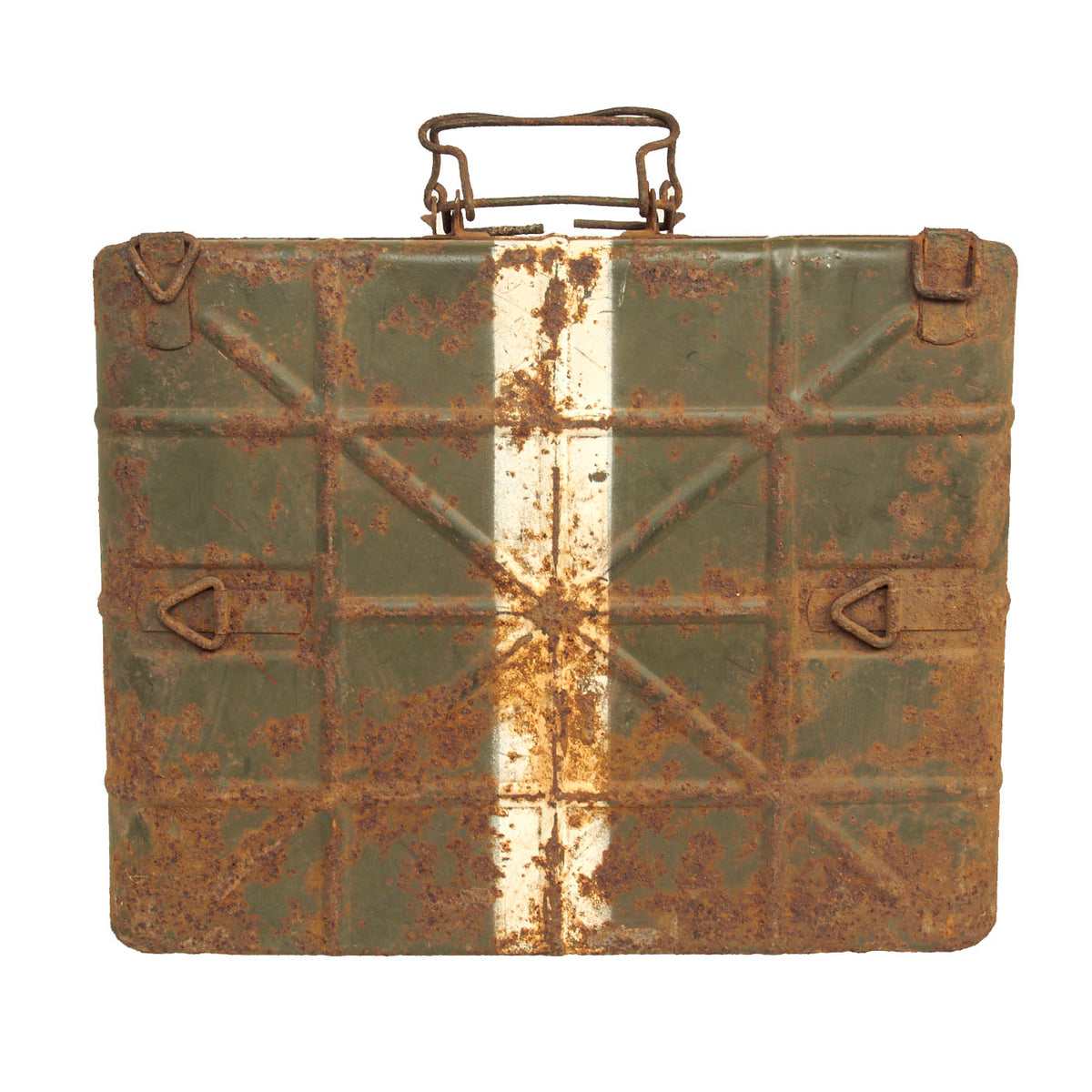Original German WWII M39 Egg Grenade Case with Original Internal Rack Original Items
$ 895,00 $ 223,75
Original Item: Only One Available. This is a very rare, nice condition original German World War Two egg grenade carry case, complete with internal rack for transporting 30 German Type Model 39 Egg Hand Grenade Eierhandgranate 39.
The case is offered in good solid condition. It still retains most original features excluding wood carry handle and cross locking system, and has some original paint. Most of the paint is missing, which has also removed the stenciled markings on the outside. There is a maker mark and code pressed into the outside handle side edge, it is difficult to read but is present.
The internal rack offered in good condition with original intact carry handle and is without hinges. The rack shows pitting from rust and wear but overall it is solid.
This is an amazing and RARE set offered in good condition, complete sets like this are nearly impossible to find!
Model 39 Grenade
The Model 39 “Eihandgranate”, M39 or Eierhandgranate 39 (“egg hand grenade”) was a German fragmentation hand grenade introduced in 1939 and produced until the end of World War II.
The Eihandgranate were issued to the Fallschirmjäger from early till the end of the war. The grenade used the same fuse assembly (the BZE 39) as the Model 43 Stielhandgranate (“Stick Grenade”), which was screwed into the top of the sheet-metal body.
To activate, the dome-shaped cap was unscrewed and pulled with a coiled pull-cord that is pulled before throwing. The color of the cap indicated the burning time of the type of fuze fitted. Typically, a delay of around 4 seconds was used. It could also be used in place of the bottom side screw cap on the “Stielhandgranate” stick grenades.
If it was to be used as a fixed booby-trap then an instantaneous or 1 second fuse would be fitted. Sometimes, this style of grenade would be discarded in plain view for the enemy to use, particularly on the Eastern Front and in the Western Front. They were used in France as part of Erwin Rommel’s asparagus. Obstacles, such as wooden poles, were used to hinder airborne landings, which could tear the wings of gliders and also kill the soldiers inside as these poles were connected with wires to either these grenades or S-mines (Bouncing Betty) against paratroopers. Later in Italy they would also be used as booby traps to slow down Allied advances on the Italian peninsula, in ambushes or in street fighting and as traps for the Italian Partisans when they raided German supplies and weapon caches. Another type of trap was to wire a short-fuse grenade to a door-frame in an abandoned building with the pull-cord attached to the door. When the door was breached by opposing troops the grenade would detonate right next to the enemy. German soldiers were easily confused with grenades that had blue color fuse caps because they could have had a 4.5 second delay or zero second delay. In order to prevent this, a red dot or a red “X” was put on the blue fuse cap or a red horizontal stripe was painted on the body of the grenade.
The offensive (high explosive) version of the grenade used a small Donarit filling which was considered extremely ineffective in comparison to the standard stick grenade models: large amounts of these grenades would be thrown in a short amount of time or at once for the desired effect.
The defensive (fragmentation) version of the grenade had a fragmentation sleeve wrapped around the exterior of the grenade, which would turn into high speed shrapnel when the grenade exploded giving it a longer range and greater damage ability to the enemy.
Fast Shipping with Professional Packaging
Thanks to our longstanding association with UPS FedEx DHL, and other major international carriers, we are able to provide a range of shipping options. Our warehouse staff is expertly trained and will wrap your products according to our exact and precise specifications. Prior to shipping, your goods will be thoroughly examined and securely secured. We ship to thousands clients each day across multiple countries. This shows how we're dedicated to be the largest retailer on the internet. Warehouses and distribution centres can be located throughout Europe as well as the USA.
Note: Orders with more than one item will be assigned a processing date depending on the item.
Before shipping before shipping, we'll conduct a thorough inspection of the items you have ordered. Today, the majority of orders will be delivered within 48 hours. The delivery time will be between 3-7 days.
Returns
The stock is dynamic and we cannot completely manage it because multiple stakeholders are involved, including our factory and warehouse. So the actual stock may alter at any time. It's possible that you may not receive your order once the order has been made.
Our policy is valid for a period of 30 days. If you don't receive the product within 30 days, we are not able to issue a refund or an exchange.
You can only return an item if it is unused and in the same state as the day you received it. You must have the item in its original packaging.
Related products
Uncategorized
Uncategorized
Uncategorized
Uncategorized
Uncategorized
Uncategorized
Uncategorized
Uncategorized
Uncategorized
Uncategorized
Uncategorized
Angolan Rebel 1970s era 60mm Inert Display Mortar from Angolan Civil War Original Items
Uncategorized
Uncategorized
Uncategorized
Armoured Fighting Vehicles of the World: AFVs of World War One (Hardcover Book) New Made Items
Uncategorized
Australian WWII Owen MK1 Machine Carbine SMG Custom Fabricated Replica with Sling Original Items
Uncategorized
Uncategorized
Band of Brothers ORIGINAL GERMAN WWII Le. F.H. 18 10.5cm ARTILLERY PIECE Original Items
Uncategorized












































































